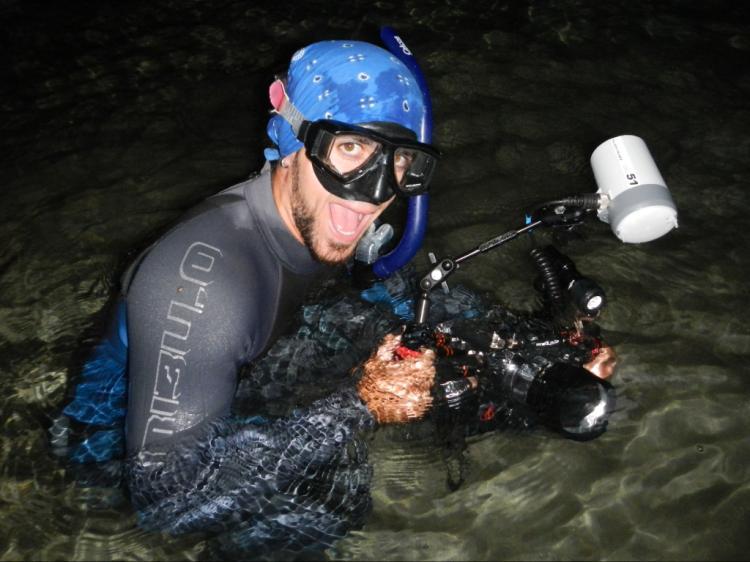Spying on fish to discover the ‘Rules of Life’
A $3 million grant from the National Science Foundation will allow CU Boulder researchers to better understand how complex species interactions affect natural ecosystems
University of Colorado Boulder marine biologist Mike Gil says, half-jokingly, that a major part of his research is “spying on fish in coral reefs, ‘Big Brother/1984-style.’”
Now, thanks to a recent $3 million grant from the National Sciences Foundation (NSF), he and researchers from three partnering universities will be able to do that in a really big way.
“I was pleasantly surprised and extremely excited when I first got word that we were successful in our attempt to secure this funding,” says Gil, an assistant professor of ecology and evolutionary biology, who led the grant proposal. He says the funding is important because there is much that researchers still don’t understand when it comes to the workings of natural ecosystems—especially coral reefs.

Mike Gil at work.
“We’re at the tip of the iceberg, at best,” he says. “How does this system behave? How is it going to respond to a disturbance, like human-driven environmental change? For those kinds of questions, we have incredible room to expand our knowledge base.”
In an attempt to answer those questions, the team of researchers has selected coral reefs in the Caribbean, French Polynesia and Southeast Asia for intensive monitoring and experimentation. The seafloor around large sections of those reefs will be surrounded by an array of video cameras to capture the behavior of mixed-species groups of herbivorous fish as they move around the reef.
“We aim to achieve a contiguous field of view, and to minimize blind spots over a spatial scale of observation that has never been attempted before. Big Brother is going to be watching—but this time, it will be fish,” Gil says with a laugh. “With this approach, we will collect an unprecedented data set on the individual behaviors of these fish. We can then use these data to tease out specific types of interactions among species.”
By studying coral reef ecosystems in different parts of the world, the researchers can identify and quantify similarities and differences, to potentially extract robust patterns across global scales, according to Gil, who adds that this research project is the largest of its kind to date.
“We certainly could benefit tremendously from having way, way more data on how species interact in the wild, and this project will contribute meaningfully to this need,” he says.
Coral reefs & ‘The Rules of Life’
Findings from this research will extend far beyond coral reef ecosystems, Gil says, offering insights on how nature broadly works, or the “Rules of Life,” as defined by the NSF.
Gil explains that, in order to create models of ecosystems, which are designed to make important long-term predictions, scientists have typically simplified biological interactions by classifying them as either negative (e.g., competitors vying for resources) or positive (e.g., cells sharing resources).
However, he notes that in nature, many different interactions occur simultaneously, such as bacteria exchanging genes conferring antibiotic resistance while competing for limiting nutrients, or trees sharing carbon through their root networks while competing for light and water. How such “dynamic interactions” affect the greater ecosystem remains a mystery.
This project can give us a more accurate understanding of how ecosystems like coral reefs and beyond are going to respond to environmental changes and disturbances largely brought on by human activities.
“We propose to tackle this complexity head on, by building these dynamic species interactions directly into ecosystem models. To do this, we need to rigorously observe these interactions in systems known to have a lot of dynamism and variability in how pairs of species interact—and, it turns out, tropical coral reef fish are a great model system for this,” Gil says.
He adds that the scope of what the researchers are attempting to categorize and analyze is massive, which is why CU Boulder is partnering on the research project with mathematical biologists, computer scientists and others from Florida Atlantic University, Cornell University and the University of New Mexico.
“We’re going to go out and rigorously collect boatloads of data on fish behavior and interactions,” says Gil, all in the hopes of figuring out how those species interactions affect the greater ecosystem.
He says that researchers will use detailed modeling to simulate how real-world, human-driven disturbances, like pollution, overfishing or climate change can affect coral reef fish populations and coral reef ecosystems at large.
“We are excited by what this deeper understanding of species interactions could teach us about conservation,” says Gil. “This project can give us a more accurate understanding of how ecosystems like coral reefs and beyond are going to respond to environmental changes and disturbances largely brought on by human activities.”

